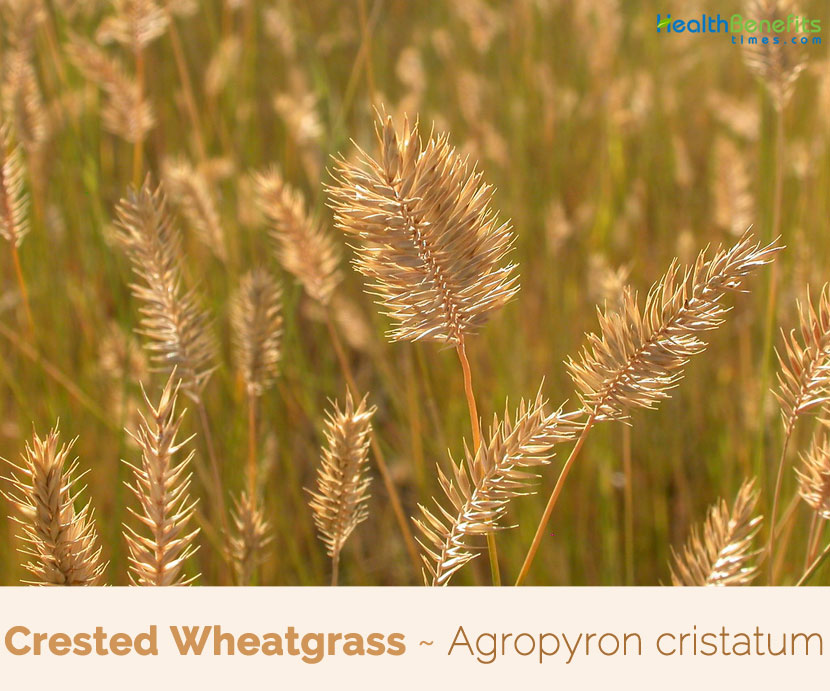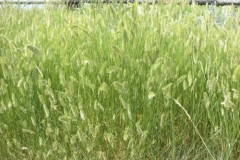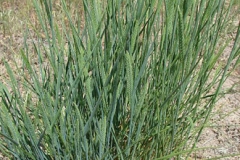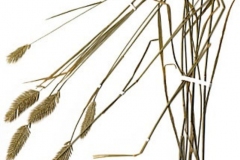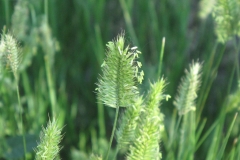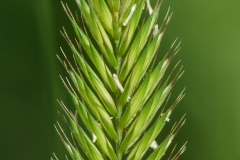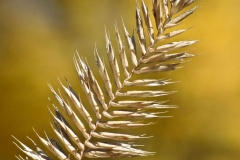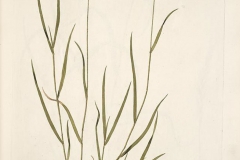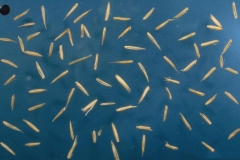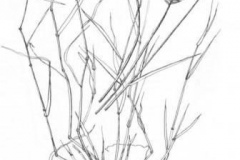Plant Description
Crested wheatgrass is a long-lived, cool season, drought tolerant, introduced, and winter hardy densely tufted grass that grows about 30–50 cm high at maturity. The plant is found growing in carbonate slopes in the forest steppe belt, on dry and inundated terraces, and in steppe woodlands. It prefers well-drained, deep, loamy soils of fine, medium or moderately coarse texture, from sandy loams to clay loams. It does not grow well in loose sandy soils or heavy clays, preferring moderately alkaline conditions with low to medium fertility. Although it does not grow well on saline soils, it can tolerate salinity. It is extremely drought tolerant and does not tolerate prolonged flooding.
Leaves and stems
Leaves are alternate, 2 to 5 inches long, 1.5 to 6 mm (to ¼ inch) wide, stiff, and flat or rolled in along the edges (involute), hairless to variously hairy. Sheaths are mostly hairless. The ligule (membrane where the leaf joins the sheath) is about 1 mm long and not fringed with hairs. Nodes are smooth. Stems are hairless, erect or sometimes spreading from the base and rising at a lower node (genticulate). Plants are clump-forming but can form dense stands.
Crested Wheatgrass facts
| Crested wheatgrass Quick Facts | |
|---|---|
| Name: | Crested wheatgrass |
| Scientific Name: | Agropyron cristatum |
| Origin | Africa, temperate Asia, and parts of Europe. It was introduced to North and South America as a forage crop |
| Shapes | Seed heads are flattened vertically, with compact overlapping spikelets. Each seed has a short awn. |
| Name | Crested Wheatgrass |
|---|---|
| Scientific Name | Agropyron cristatum |
| Native | Africa, temperate Asia, and parts of Europe. It was introduced to North and South America as a forage crop |
| Common Names | Crested wheatgrass, Fairway crested wheatgrass, Fairway wheatgrass, desert wheatgrass, crested couch grass, standard crested wheatgrass |
| Name in Other Languages | Arabic: Quzuf eurfiun (قزوف عرفي) Bulgarian: Grebenoviden zhitnyak (гребеновиден житняк), zhytnyk (житник) Catalan: Agropir pectinat Chinese: Bing cao (冰草) Croatian: Pirika Czech: Pýr hrebenitý, žitňák hřebenitý Danish: Kamkvik English: Crested wheatgrass, Fairway crested wheatgrass, Fairway wheatgrass, desert wheatgrass, crested couch grass, Finnish: Harjasvehnä French: Agropyre à crête, Chiendent à crête, agropyron accrete, chiendent pectiné German: Kammquecke, Kamm-Quecke Greek: Agropiron to lofodes (Αγρόπυρον το λοφώδες), agropiro (αγροπιρο) Hungarian: Taréjos búzafü Italian: Agropiro crestato, Gramigna crestata Japanese: Kuresuteddo hoiito gurasu (クレステッドホイートグラス) Kazakh: Erkek şöp (Еркек шөп) Mongolian: Saman erxög (Саман ерхөг) Norwegian: Kamkveke Polish: Perz grzebieniasty, Perzu grzebieniastego, perzyk grzebieniasty Russian: Zhitniak grebenchatyi (Житняк гребенчатый), grebenoviden zhitnyak (гребеновиден житняк) Serbian: Češljasta pirevina (чешљаста пиревина) Slovak: Zitňak hrebenitý Spanish: Agropiro, Agropiro crestado (Argentina), Triguillo crestado, agropiro de crista Swedish: Kamvete Turkish: Otlak ayrigi Ukrainian: zhytnyak hrebinchastyy (житняк гребінчастий), jitnyak karadazkiy (житняк карадагський), zhytnyak lavrenkiv (житняк лавренків) |
| Plant Growth Habit | Long-lived, cool season, drought tolerant, introduced, and winter hardy densely tufted grass |
| Growing Climates | Carbonate slopes in the forest steppe belt, on dry and inundated terraces, and in steppe woodlands |
| Soil | Prefers well-drained, deep, loamy soils of fine, medium or moderately coarse texture, from sandy loams to clay loams. It does not grow well in loose sandy soils or heavy clays, preferring moderately alkaline conditions with low to medium fertility |
| Plant Size | 30–50 cm high at maturity |
| Root | Fibrous roots |
| Stem | Hairless, erect or sometimes spreading from the base and rising at a lower node |
| Leaf | Leaves are green to slightly blue-green with rough margins and upper surface veining. The leaf sheaths are open, and the lower sheaths smooth to somewhat hairy and sometimes purple in color |
| Flowering season | April- mid-June |
| Flower | Inflorescence a dense spike 3-9 cm. long, the rachis pubescent; spikelets sessile and solitary, several times longer than the internodes, spreading-ascending, 7-12 mm. long, mostly 5- to 7-flowered; glumes and lemmas with awns 2-4 mm. long |
| Fruit Shape & Size | Seed heads are flattened vertically, with compact overlapping spikelets. Each seed has a short awn. |
| Propagation | By seed and also by short rhizomes |
| Other Facts |
|
Flower
Spike-like cluster at the top of the stem, 1 to 4 inches long, the spikelets (flower clusters) ascending to spreading, alternately arranged on opposite sides of the stalk (2-ranked) and mostly evenly spaced like the teeth of a comb, though the upper spikelets may be more crowded and occasionally spikelets are more irregularly arranged. Spikelets are stalk less or nearly so, light green at flowering time, 7 to 16 mm (to ~2/3 inch) long, flattened, lance-elliptic in outline and have 3 to 6 florets; the floret at the tip may be sterile. The spike stalk (rachis) is often covered in long, apprised hairs.
At the base of a spikelet is a pair of bracts (glumes), both 3 to 6 mm long including a 1 to 3-mm awn, 3-veined, strongly keeled, sometimes with a few long, spreading hairs on the keel, the upper glume usually slightly longer than the lower glume and both shorter than the spikelet. Florets are surrounded by a pair of bracts (lemma and palea), the lemma 5-veined, 5 to 9 mm long including a 1 to 6-mm awn, sometimes with a few long, spreading hairs along the keel; the palea is about as long as the lemma (excluding the awn), 2-veined with a few teeth along the veins
Fruits
Seed heads are flattened vertically, with compact overlapping spikelets. Grains (seeds) are oblong and hairy at the tip. Seeds produced may remain practical in the soil for up to five years. Crested wheatgrass is also able to spread vegetatively through the production of tillers. The plant may regrow in the fall if moisture is sufficient.
Agropyron cristatum is known among other grasses and wheat for its relatively high granivory. Granivory, or granivores, describe the interaction between animals and seeds. Agropyron cristatum’s high granivory indicates that animals feed on the seeds of the plant as their primary, or even exclusive, food source. Although this raises concerns about the plant’s continued ability to reproduce if its seeds are all being consumed, the high granivory of this species does indicate that Agropyron cristatum is an important food source.
History
Crested wheatgrass is native to Russia or the desert regions of southern Siberia and is now considered naturalized in North America. The plant was introduced to North America in the 1930s, and has been planted as a forage species since. Crested wheatgrass was also seeded to reduce soil erosion on abandoned farmlands. The ability of the plant to establish and remain productive in an area for a long period of time has become a concern. In North Dakota, crested wheatgrass has been found throughout the state and has been reported in most counties.
Crested Wheatgrass Varieties
Crested wheatgrass should not be confused with Agropyron desertorum, though the two are closely related. Hycrest is a hybrid between A. cristatum and A. desertorum. There are a number of crested wheatgrass varieties.
Fairway
It was introduced or released in 1983, from Ankara Turkey. Fairway has a rhizomatous growth habit which makes it well suited for soil stabilization.
Ephraim
It was released in 1994 and is a hybrid of four accessions. Quality forage value, high seedling vigor.
Roadcrest
It was introduced or released in 1998 from Iran/Turkey. Roadcrest is shorter and has a finer leaf texture those other varieties, and as the name suggests, is used for roadside reclamation and low maintenance turf areas. It is more sod forming and less clumpy than other crested wheat grasses.
Kirk
It was introduced or released from Siberia in 1297. It is a short and fine-stemmed and is capable of forming sod in dry land areas.
Different Uses of Crested wheatgrass
Grazing/rangeland/hayland
Crested wheatgrass is commonly recommended for forage production. It is edible to livestock and wildlife and is a desirable feed in spring and in the fall if it re-grows enough. It is used for cattle and horse winter forage, but protein supplements are required to ensure good animal health. It endures heavy grazing pressure (65% use and greater) once stands are established. The best forage types in order are Siberian, desertorum, and Hycrest.
Erosion control/reclamation
Crested wheatgrass is useful for soil stabilization. They compete well with other aggressive introduced grasses, but because of this trait, they are not compatible in mixes with native species. Their drought tolerance, fibrous root systems, and good seedling vigor make these species ideal for reclamation in areas with 8 to 20 inches annual precipitation. These grasses can be used in urban areas where irrigation water is limited to provide ground cover and to stabilize ditch banks, dikes, pipelines, power lines and roadsides.
Wildlife
Birds and small rodents eat crested wheatgrass seeds; deer, antelope and elk graze it, particularly in spring and fall. Upland and song birds utilize stands for nesting.
Control
Management objectives for crested wheatgrass control should involve prevention, early detection, and containing established populations. Eliminating or reducing seed production and vegetative spread of established populations is also important. Seeds of crested wheatgrass can remain viable in the soil for up to five years; thus, infestations should be monitored for several consecutive growing seasons to prevent germination of new plants. Control methods should be combined into an integrated management system for the best long-term control of the plant. Management techniques should be site specific, determined by land use objectives, degree of crested wheatgrass infestations, desired plant community, and efficiency and limitations of available control measures. Control methods should be implemented to stress crested wheatgrass more than desirable, native species.
Mechanical
Mowing crested wheatgrass mid-season or when the plant is in the elongation stage can prevent the plant from going to seed, since carbohydrate reserves are being drawn down at this time for growth and reproductive structures. Consequently, regrowth may be minimal because carbohydrates may not be quickly refilled. Burning may be an effective control method if conducted prior to seed set and before the plant goes dormant. However, burning may only reduce the top growth of the plant, leaving underground tillers to survive. In North Dakota, crested wheat grass was reduced the first year in tall grass prairie sites, but was able to recover and was stimulated on some sites after a prescribed burn conducted in May. Prescribed burns may also unfavorably affect native grasses. Further research is desirable to determine the effects of prescribed burns for crested wheat grass control.
Chemical
Several herbicides are available to control crested wheat grass, although most are not specific to the plant. Picloram, dicamba, glyphosate, and imazapic have all been successful. Contact your local county extension agent for recommended use rates, locations, and timing.
Biological
No insect biological control agents are currently available for the control of crested wheat grass. The plant is palatable to livestock and can provide good forage in the spring when in the vegetative growth stage. Grazing should be conducted during the elongation growth stage of the plant to control crested wheat grass. Populations that are grazed when plants are lengthening or growing are less likely to produce seeds and may not re-grow. However, crested wheat grass may become unpalatable as the plant matures.
References:
https://www.itis.gov/servlet/SingleRpt/SingleRpt?search_topic=TSN&search_value=40371#null
https://npgsweb.ars-grin.gov/gringlobal/taxonomydetail.aspx?id=102774
https://www.cabi.org/isc/datasheet/3723
https://plants.usda.gov/core/profile?symbol=AGCRP8
https://en.wikipedia.org/wiki/Agropyron_cristatum
http://www.theplantlist.org/tpl1.1/record/kew-388313
https://gd.eppo.int/taxon/AGRCR
https://plants.usda.gov/plantguide/pdf/pg_agcr.pdf
http://www.library.nd.gov/statedocs/agdept/crestedwheatgrass20070518.pdf


